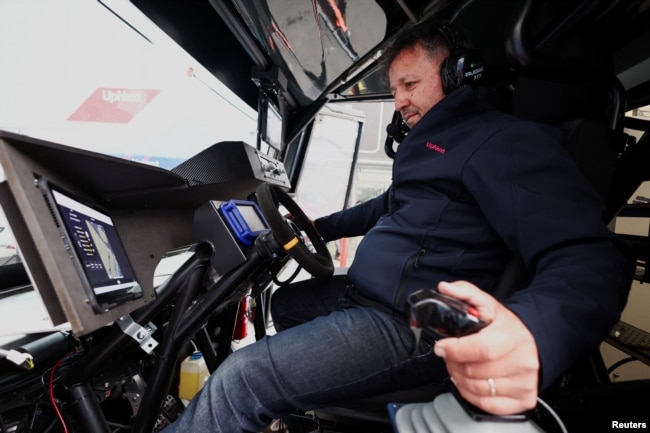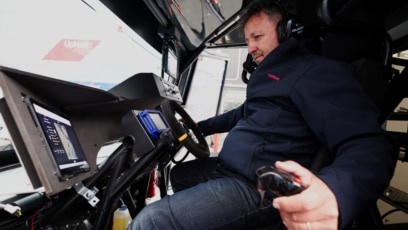European aerospace company Airbus has fitted a special truck with airplane controls in an effort to test self-taxiing abilities.
Airbus officials recently introduced the truck in Paris at Europe’s largest technology event, VivaTech. The electric vehicle can drive like a truck, or it can activate the aircraft system controls.
A demonstration showed how the truck works. It uses numerous cameras and sensors to help follow airport direction signals and avoid obstacles as computers guide the vehicle along its path.
In a statement, Airbus described the effort as a three-year research project called Optimate. The goal is to deploy and test the best technologies to help aircraft better recognize their surroundings and current operating conditions.
In addition, the company said detailed data from the experiments will be examined to help develop pilot assistance systems for airport taxiing.

The technology demonstration came after several incidents of airplanes crashing on the ground at airports. One of those happened in January, when a Japanese Airlines Airbus350 was landing and hit a coast guard plane already on the runway.
An investigation was launched last month after a British Airways jet struck a stationary Virgin Atlantic plane at London’s Heathrow Airport. That crash caused only minor damage to both aircraft.
And in February, U.S. investigators said they were looking into a crash involving two JetBlue planes at Logan International Airport in Boston.
Airbus officials have said they hope the specially designed truck can show how self-taxiing, or automation, technology can help safely guide costly jets through increasingly crowded airports. The vehicle uses multiple technologies related to automation, navigation and artificial intelligence (AI).

Matthieu Gallas is the head of automation research at UpNext, a special technology research laboratory for Airbus. He told Reuters news agency, “These use cases are much more critical and complicated compared to those of the car industry.”
Slow-speed airport crash incidents rarely result in serious injuries or deaths. But they represent a costly and growing problem for airlines, airports, insurers and passengers. Such incidents can cause major passenger delays. They also can lead to costly plane repairs.
The chief executive of UpNext is Michael Augello. He said in a statement that a big aim of the Optimate project is to demonstrate a new system to support “safer and more efficient air travel.”
The UpNext team says the refitted truck is to be tested live at airports in preparation for testing A350-1000 aircraft in the future.
Company officials say if the airport tests are successful, the project could also result in airplane design changes. But getting such systems approved can be a long and difficult process.
Gallas said Airbus jets already use some automation technologies to limit pilot error. But those systems are not considered fully autonomous. In other words, they can only predict and behave in certain situations.
The testing truck is equipped with light-based LiDAR technology. LiDAR uses a series of sensors and light lasers that can measure distances and produce three-dimensional (3D) maps of the surrounding environment.
Airbus said the research vehicle is expected to explore progressively higher levels of automation as the experiments continue. The company noted it has no immediate plans to introduce autonomous jetliners to the skies.
Karim Mokaddem is a former automobile executive. He now leads research and technology for Airbus. He told Reuters he thinks LiDAR will be the most effective technology for the testing vehicle.

The possible use of LiDAR to improve aircraft safety recently received attention after severe turbulence hit a Singapore Airlines jet. That incident left one passenger dead and several others injured.
Researchers have looked at LiDAR technology as a possible way to identify and track possibly dangerous air currents that may not be picked up by radar equipment.
Reuters reported that Boeing began testing such a system in 2018. Technology experts are looking to possibly expand LiDAR as a tool to help predict turbulence.
I’m Bryan Lynn
Reuters and Airbus reported on this story. Bryan Lynn adapted the reports for VOA Learning English.
Quiz – Airbus Truck Fitted with Airplane Controls to Test Self-taxiing

Start the Quiz to find out
__________________________________________
Words in This Story
efficient – adj. working well and not wasting time or energy
obstacle – n. a barrier that makes it difficult to get something done
navigation – n. a system to find the right direction to travel by using maps or electronic equipment
taxi – n. the movement of an aircraft as it drives on the ground after landing
complicated – adj. involving a lot of different parts or information that is difficult to understand
turbulence – n. unsteady or violent movement of air or water
track – v. follow something closely
